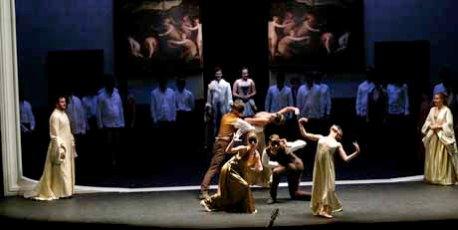André-Cardinal Destouches - Le Carnaval et la Folie (2008)
André-Cardinal Destouches - Le Carnaval et la Folie (2008)

1. Act I 2. Act II 3. Act III 4. Act IV Paul Henry Vila - Carnaval Mélodie Ruvio - Folie Marduk Serrano Lopez - Momus Reinoud van Mechelen -Plutus Emmanuelle de Negri - Jeunesse Marc Callahan - Jupiter Marion Tassou - Vénus Marc-André Pronovost - Chef des Matelots Enrique Alberto Martinez Rivero - Professeur de Folie Daniel Cabena : Un Musicien Sorin Dumitrascu - Un Počte Academie Baroque Européenne d’Ambronay Hervé Niquet – conductor Concert donné le 1er février 2008, Salle Favart-Opéra comique a Paris Comédie-ballet en quatre actes et un prologue de André-Cardinal Destouches (Livret d'Antoine Houdar de La Motte d’après L'Eloge de la Folie d'Érasme) créé à Fontainebleau le 14 octobre 1703 et à l'Académie royale de musique le 3 janvier 1704.
I suppose that some of my readers will be more familiar than I am with this composer and this opera and I must confess that I had never heard of either before now. I also had to go to Valladolid – not renowned for adventurous programs - to discover this fun baroque opera: not my usual description of works of that period. André-Cardinal Destouches belongs to the French baroque period and his works, particularly Le Carnaval et la Folie were a great success apparently. Le Carnaval had its premiere in 1703, not in Versailles, but in Fontainebleau and not in the presence of Louis XIV either, but with the King of England there instead. The success of the work owed something to the fact that it was the first musical comedy presented in France, after which Rameau's better known Platée followed. The libretto narrates the relationship between Carnival and Madness and has a happy ending ultimately. Appearances by allegorical and mythological characters are very frequent, and verses in which there are references to even more deities are heard all the time. This work has more Gods and demigods than in Das Rheingold.
By way of a few clues, among the characters singing in the opera, aside from Carnival and Madness, we meet Jupiter, Venus, Pluto, Momus and Youth and mentions of others are innumerable. The music is very easy listening and was a real discovery for me. The opera raised much enthusiasm in 18C France - as it did it here – and a particular gem is the Divertimento of the third act, known as “Il Divertimento of the Professor of Madness”, offering an amusing lesson in Italian song to a musician, a lesson of dance to the dancers and a lesson of rhyme to a poet. All done with a great sense of humor.
This version was semi-staged, with direction by Jean-François Daignault, who made an outstanding job of it. Since it's really an opera-ballet, as was usual during the French baroque, he makes a very good use of five dancers, while at the same time managing to make true actors from the members of the Chorus, all of whom also sing wonderfully.The care for detail is particularly remarkable and is done with great originality and affection. Most so-called semi-staged operas are really thinly disguised concerts but in this case, the production only needed sets and lights to become fully staged.
The Académie Baroque Européenne d' Ambronay, directed in this occasion by Hervé Niquet are authentic baroque experts. The Academy was founded on 1993, so is now in its 'XIV edition' and is an extremely praiseworthy project. Its main objective is the education and training in the interpretation of baroque opera for young artists coming from all over Europe. Every year, singing, dancing and musical young people, gather to study baroque music under the leadership of prestigious conductors like William Christie, Christophe Rousset, Gabriel Garrido, Ricardo Alessandrini, Jordi Savall and Paul McCreesh who have shared responsibilities in the past. They are now joined by Hervé Niquet, a worthy recruit to their ranks.
After several weeks of work in France, the Academy takes a selected opera on an international tour. The whole project seems very interesting and the results are more than surprising because the Orchestra offers high quality performances, comparable with the best known established baroque groups. The chorus (always recruited from the youngsters in the Academy) is an example both of musicality and scenic credibility. The dancers also contribute to the ensemble's overall quality perhaps the only slightly black mark – more grey really - is the standard achieved by the solo singers. The musical level is really very high. Mr. Niquet believes in this music and he is able to transfer his enthusiasm to both his collaborators and to the audience.
The purely vocal performances are not quite at the same level and perhaps the Academy might attempt to put more care in selecting young singers or perhaps extend their study time Those showing the most promise were soprano Emmanuelle de Negri (Jeunesse) and bass Sorin Adrian Dumitrescu (Jupiter). Unfortunately, the three main protagonists: Folie (Camilla Merckx), Carnival (Mark Callahan) and Momus (Marduk Serrano Lopez) offered voices below the highest standards, but the tenor Enrique Alberto Martinez Rivero as Le Professeur in the Divertimento was very amusing indeed.
As happened for the Kasarova concert last week at Valladolid's Concert Hall, the Centro Cultural Auditorium had many empty seats once again. The reaction of the public who were there though, was very warm indeed with many ovations and cheers for the company, obliging them to take repeated bows. It was a very interesting evening and I advise opera lovers who can make a day trip to Valladolid to go to it if they can. The scheduled programmed is definitely worth the trip, and so are the prices, by the way. ---José M. Irurzun, musicweb-international.com
download (mp3 @320 kbs):
salefiles yandex 4shared mega mediafire zalivalka cloudmailru uplea
